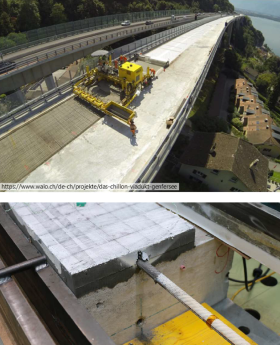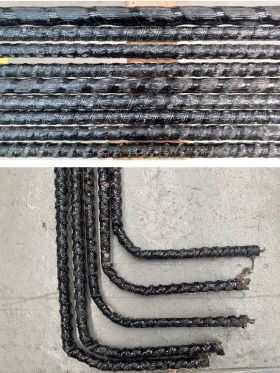Innovative Concrete Structures
Our group develops innovative solutions to extend the service life of existing concrete structures and contribute to the development of sustainable new constructions. In close collaboration with our research and industry partners, we explore novel building materials and methods such as iron-based shape memory alloys (Fe-SMA), ultrahigh performance fiber reinforced concrete (UHPFRC), and advanced strengthening systems with CFRP strips using novel adhesives and bonding techniques.
We also work on durable reinforcement alternatives for concrete using fiber reinforced polymers (FRP). This includes using sustainable bio-based and synthetic fibers, as well as recyclable thermoplastic matrices that will enable the production of diverse reinforcement shapes needed for structural applications. In addition, we investigate sustainable concretes such as low-clinker and steel-slag concretes, to further reduce the environmental impact of construction materials.
Beyond research, we are engaged in education, passing our findings and expertise to future civil engineers through courses at ETH Zürich and the University of applied Science OST in Rapperswil, Switzerland.
Two examples of our research projects are shortly described below:
Strengthening of bridges using a layer of UHPFRC reinforced with memory steel

The goal of this research project is to develop an efficient and economically feasible alternative to existing strengthening methods for bridges. The use of prestressing techniques for strengthening purposes has the advantage of providing better performance under service loads. The innovative method consists in applying a top layer of Ultra-High Performance Fibre Reinforced Concrete (UHPFRC) reinforced with memory steel over the parent Reinforced Concrete (RC) structure. Besides being able to enhance the load-carrying capacity of the original structure, the novel approach can potentially reduce crack widths, uplift excessively deformed structural elements and reduce the stresses in the internal reinforcement. To study novel technology, several experimental campaigns are performed in order to characterize the materials behavior, and the bond behavior between Fe-SMA and UHPFRC. The overall performance of the retrofitting method will be investigated in upcoming large-scale tests on cantilever slabs. High resolution technologies that use distributed fiber optical sensors (DFOS) are being implemented in experiments to accurately measure the strains along fully embedded reinforcing bars, ultimately contributing to a better understanding of the bond interactions.
Lastly, at the end of the Innosuisse research project, a pilot application is planned. The potential application of the strengthening system on an existing bridge would enable us to demonstrate the feasibility and efficiency of the system when installed in a real-scale structure.
Project Partners:
https://www.re-fer.eu/en/
https://www.cemsuisse.ch/en/
Basalt fiber reinforced polymer (BFRP) concrete reinforcement

Basalt fiber-reinforced polymers (basalt FRP), the newcomer among fiber-based composites is particularly attractive for up-scaling due to a low price of the basalt fibers and wide availability of raw materials in Switzerland and globally. A potential of this technology for infrastructure applications has been shown in a research project carried out by the group together with Swiss road authorities (FEDRO/ASTRA). Currently, the group is conducting an Innosuisse funded project in collaboration with the Swiss company SME Plüss Mechanics & Composites, with the goal of establishing the basalt FRP reinforcing bar production in Switzerland. The mechanical properties of the bars are investigated, and their surface finishing is optimized to enhance their bond with the surrounding concrete. The long-term durability of the developed bars in concrete alkaline conditions and reduction of the tensile strength is studied in creep tests. In the following step, the developed basalt bars will be implemented in a pilot project at the new NEST Unit Beyond Zero and design strategies will be proposed for engineering practice to promote their use in the construction industry.
Project Partner:
https://pluessag.ch/

-
Share
